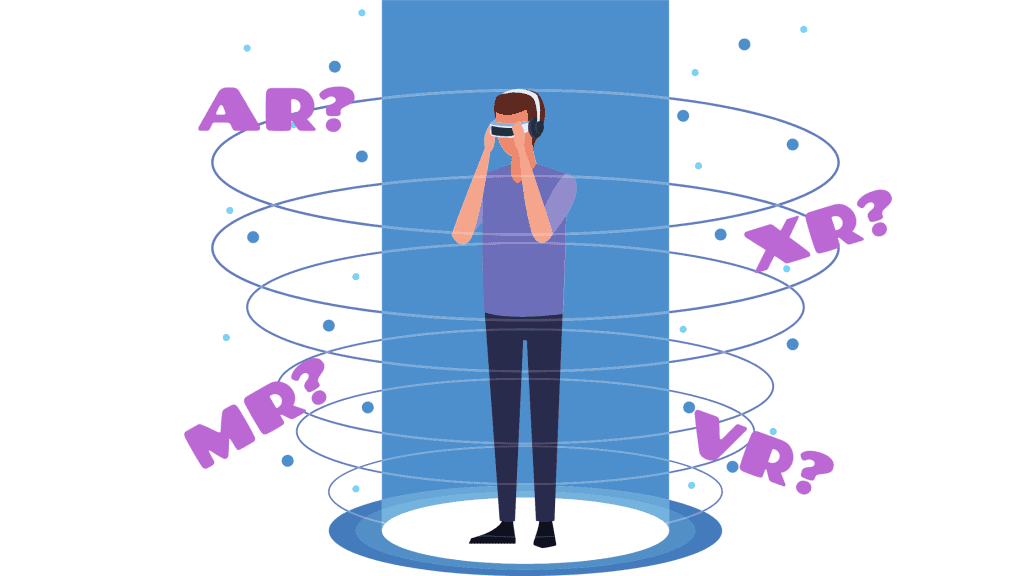
VR vs AR vs XR… with all these abbreviations, it is easy to get confused. So what do they mean?
If you’re looking for a quick and easy answer, here it is: while Virtual Reality (VR) creates an immersive experience where a real-world environment is completely substituted with a simulated one, Augmented Reality (AR) supplements your surroundings combining your live view with digital elements in real time, usually through the use of your phone or another digital device. Mixed Reality (MR) is similar to AR with the addition of physical and digital elements being able to interact. Extended reality (XR) is an umbrella term used to describe immersive learning technologies that simulate reality – it covers all of the above.
Still confused? Don’t worry, we will discuss the not so quick, yet still easy answer down below by explaining each term in more detail, starting out with the universal term “Extended Reality”.
What is Extended Reality?
Let’s start off short and sweet: Extended Reality (XR for short), also known as Cross Reality, is an umbrella term for immersive learning technologies that create computer-generated environments or objects. This includes VR, AR and MR, as well as all future established forms of this technology, meaning the term can be extended anytime – just like reality.
Are you talking about any and all kinds of reality technologies without singling out a certain one? Then use the term XR.
So far so good – time to move on to its subcategories.
What is Virtual Reality?
Creating reality
Virtual Reality, VR for short, refers to a computer-simulated artificial environment that is crafted with the goal to suspend your disbelief and ‘transport’ you to the virtually created reality. VR hardware allows you to enter a 360-degree virtual environment in which you can move freely and interact with virtual content – full immersion is the key.
It might sound a lot like a simple 360 degree video, there are some differences to 3D Virtual Reality though. If you are curious about Virtual Reality in general, you can learn all about it here.
Virtual Reality hardware and content
To enter Virtual Reality, the most important piece of hardware is a headset, through which you can consume your VR content. Depending on the kind of headset you chose, you also need other equipment, like a computer or controllers. VR calls for features such as motion capture (3DoF or 6DoF), and VR tracking for truly immersive entertainment experiences.
Creating a fully virtual reality also means having a limited number of possibilities for content. From quality 360 videos, images, application, games to VR training – you can decide how you want to make use of VR. To keep track and make the most of your content, we recommend using a VR Content Management System.
What is Augmented Reality?
Complementing Reality
AR is a technology that superimposes computer-generated imagery onto the real world – or rather the user’s view of it. Usually, this is done by inserting information, 3D models or videos.
The way they are overlaid is determined by the type of viewing experience in question as well as the piece of hardware you’re using to view it.
AR hardware and content:
The most accessible way to consume AR is directly with your phone. Mobile AR applications use your camera view and add digital elements to it – the most famous example probably being Pokemon Go. It can be used for more than gaming though: it can help with navigations by giving directions or function as guides for exhibitions or or or… the possibilities are endless.
This of course limits the immersion, as the AR elements are confined to a phone-sized camera view. Just like for VR, there are special headsets and smart glasses, like the Microsoft Hololens, that make for a more well-rounded experience.
Are you interested and make use of AR for yourself or your business? Then check out the services that Smart VR Lab has to offer here.
What is Mixed Reality?
Between AR and VR
We discussed VR and AR, but what in the world is MR aka Mixed Reality? Well, it is something in between.
In the AR environment, you can see a merged view of real-world elements and virtual elements. What is not possible, however, is an interaction between the digital elements and the ones of the physical world. This is where MR comes in.
MR enables not only the superimposition of digital elements with the real surroundings, it also allows the user to see and interact with both the virtual as well as the physical environment. Therefore, MR experiences get input from their environment and change correspondingly.
Mixed reality technology is only just getting started, Microsoft’s HoloLens is amongst the most noteworthy early mixed reality devices.
A simple way to understand the differences between VR, AR and MR is by showing a practical example:
Virtual Reality (VR) Office:
A fully animated office space where your simulated avatar is able to move around and interact with the virtual furniture and equipment, or the avatars of other people.
Augmented reality (AR) Office:
A live view of your own real office that allows you to virtually decorate it with different colours or wallpaper, or bring up simulated screens to read emails or watch videos.
Mixed Reality (MR) Office:
This is also a real-time view that also displays virtual people or objects, but lets real and artificial elements interact, such as placing a virtual pencil on a real table.
AR vs VR vs XR – What now?
Now that all those terms are cleared up, you can make an informed decision on where to go from here. Maybe you are only interested in one of these mentioned technologies or you feel like making use of more than one – all can provide different benefits to you as a private person or to your business. Want to implement VR for your business? Then check out our guide on how to do that.
Smart VR Lab develops and produces training content for businesses across multiple industries. High quality VR content for a low risk of side effects. To transform your business, simply contact Smart VR Lab for a demo and set up a meeting with our team. If you have questions on anything related to VR, you can always send us a mail to info@smartvrlab.nl
Request a VRee trial
For a free 4-week trial, demo or simply more information,please leave your email.
